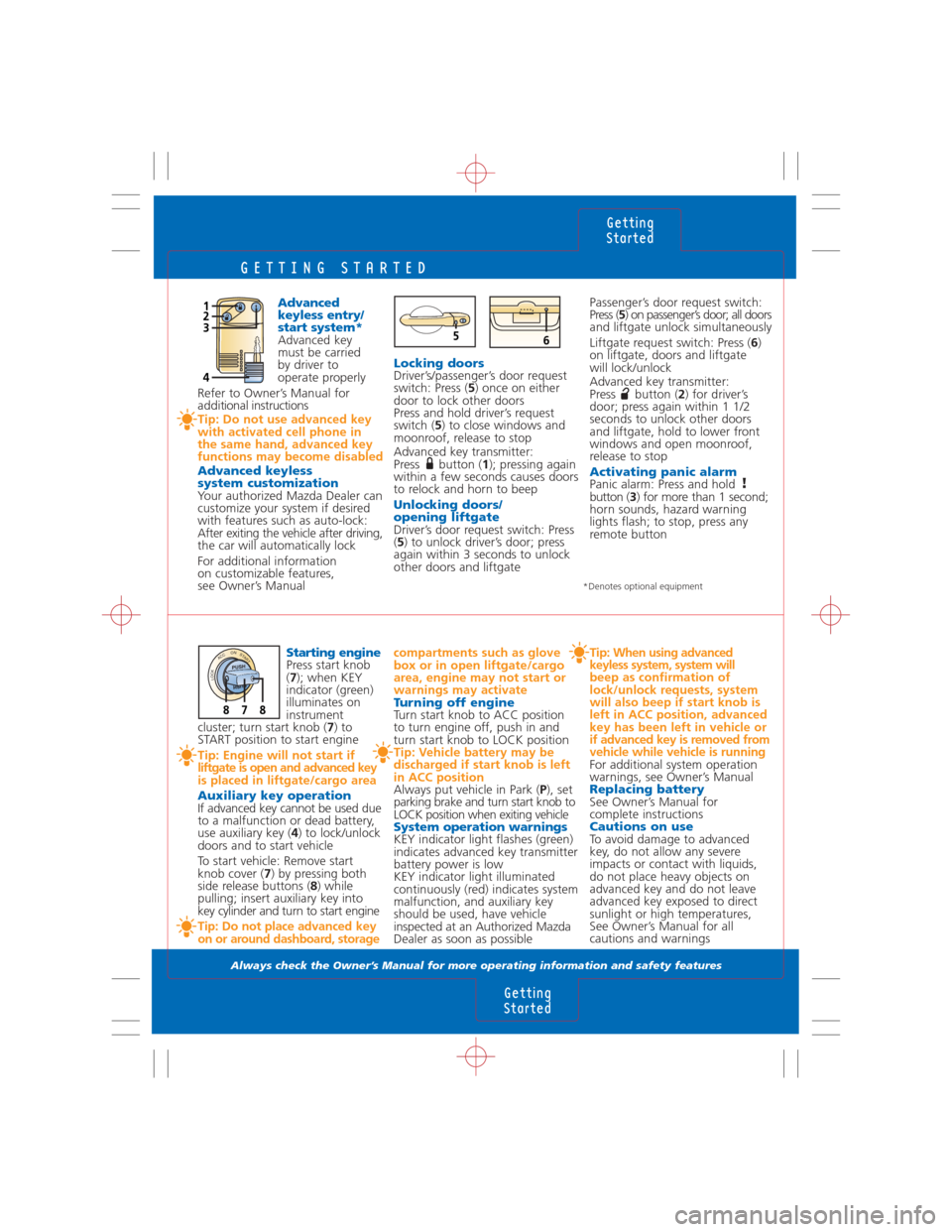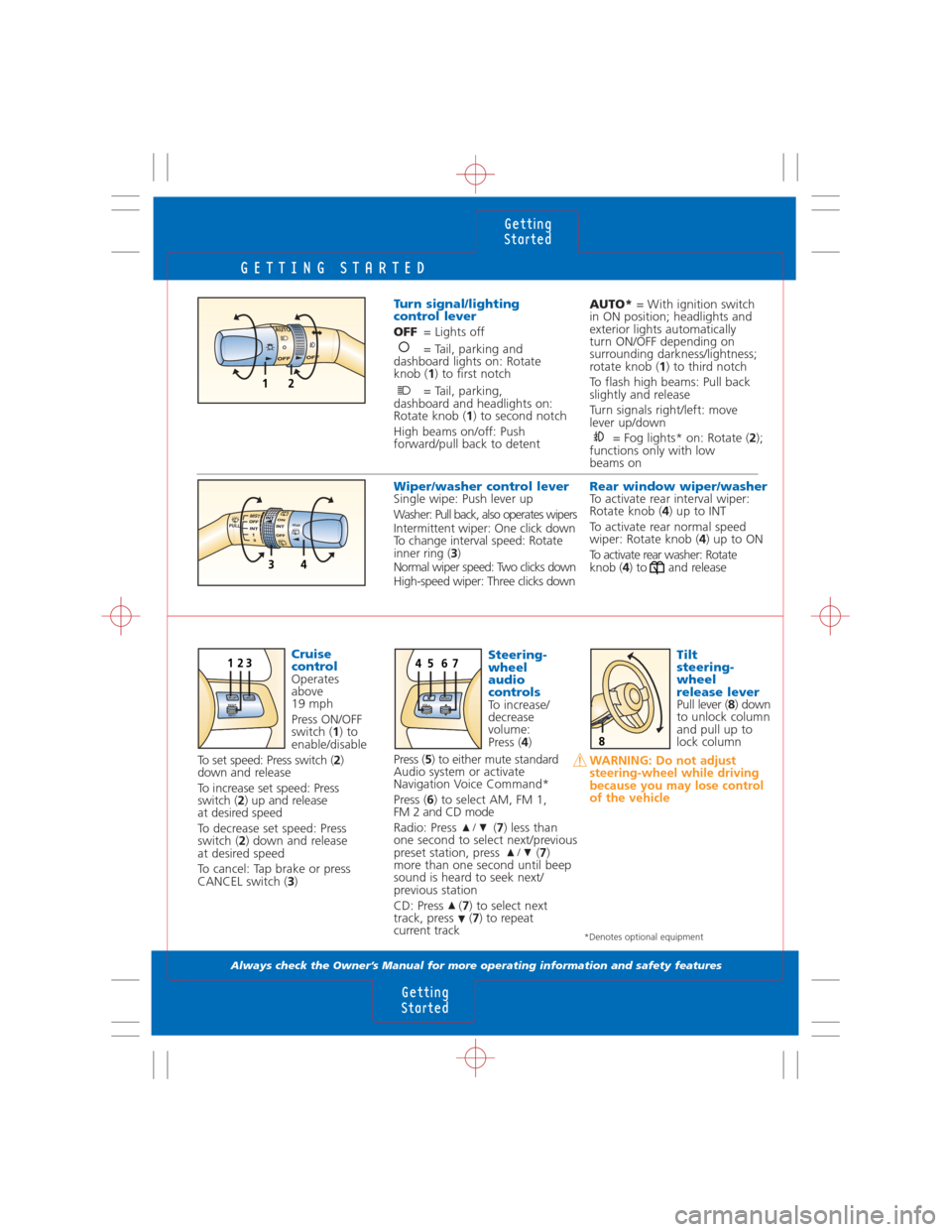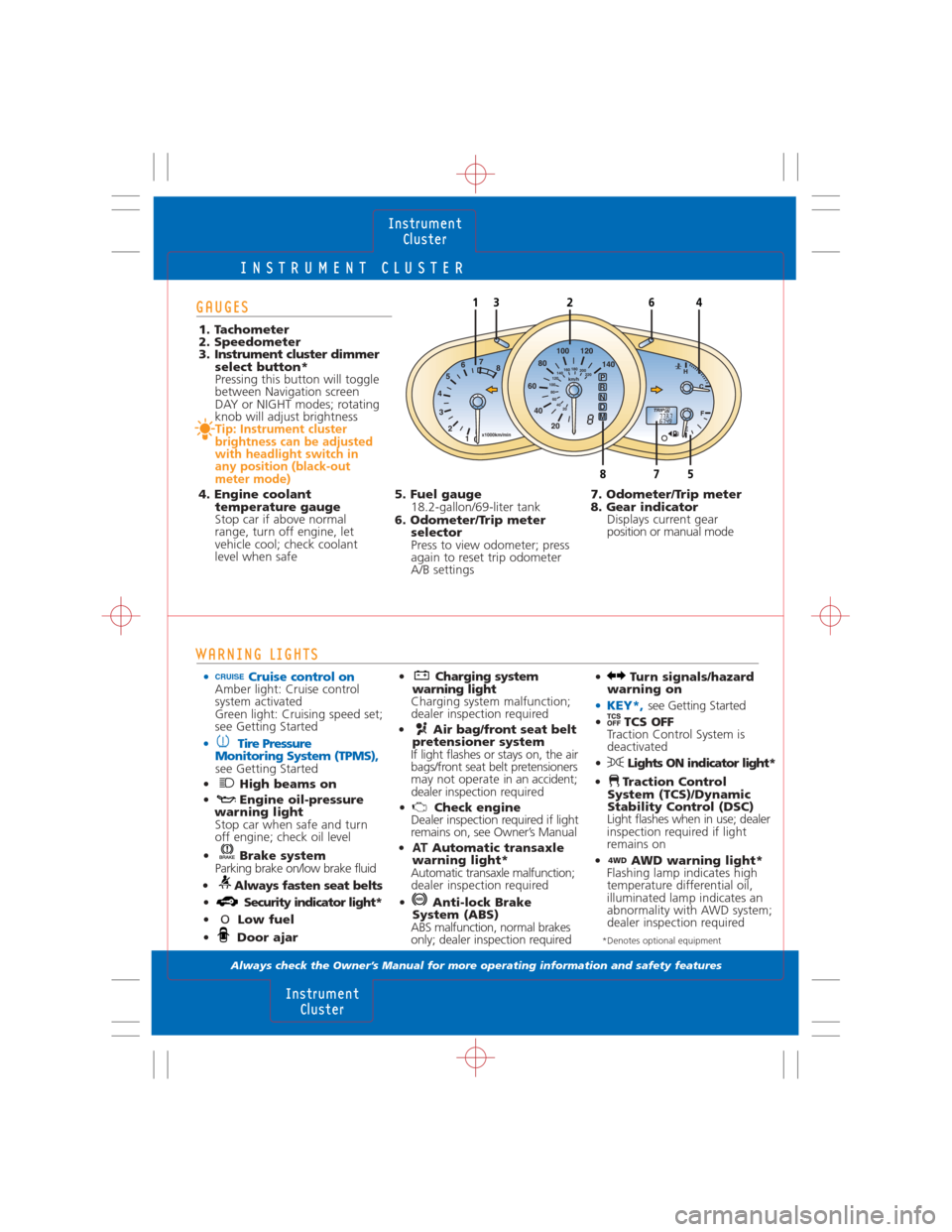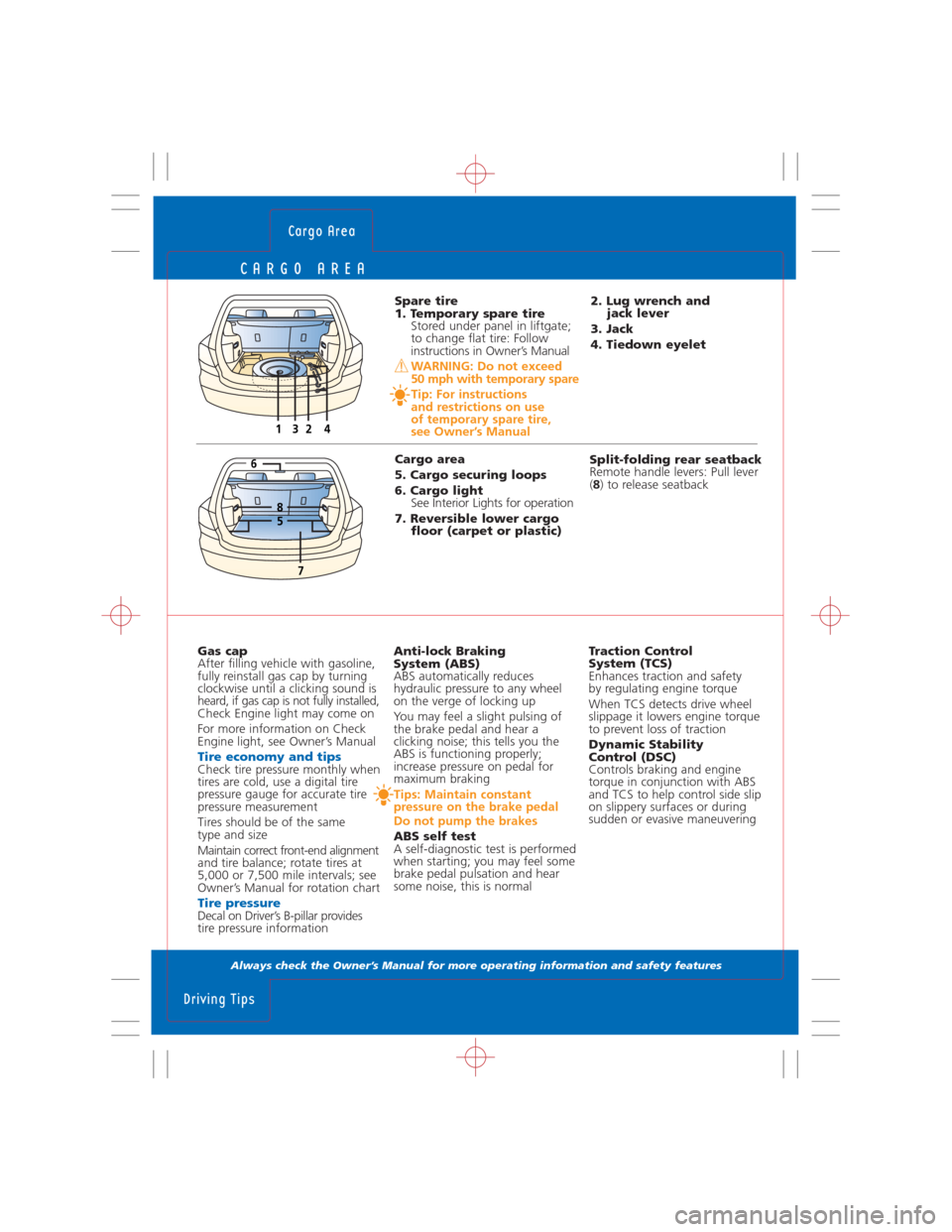brake light MAZDA MODEL CX-7 2007 Quick Tips (in English)
[x] Cancel search | Manufacturer: MAZDA, Model Year: 2007, Model line: MODEL CX-7, Model: MAZDA MODEL CX-7 2007Pages: 14, PDF Size: 1.77 MB
Page 2 of 14

DRIVER’S VIEW
Always check the Owner’s Manual for more operating information and safety features
1. Power window switches,
see Mirrors/Windows
2. Door locks,
see Locks
3. Mirror controls,
see Mirrors/Windows
4. Headlight leveling switch*, see Getting Started
5. Air vents
6. Turn signal/lighting
control lever,
see Getting Started
7. Audio control switches,see Getting Started
8. Horn/Air bag
To beep: Press
9. Cruise control, see Getting Started
10. Wiper/washer
control lever,
see Getting Started11. NAVI display*,
see Owner’s Manual
Audio system,
see Audio Systems
12. Information display,see Information Display
13. Hazard warning
switch/light
Push to activate/deactivate
14. Passenger air bag
off indicator,
see Getting Started
15. Bottle holder
CAUTION: Use plastic
bottles with caps, cups may
spill when door is closed
16. Climate control panel,
see Climate Controls
17. Accessory socket
18. Seat warmer*
Press: On/off
Driver’s
View
TRIPA773.7
67498
H140
8 7
6
5
4
3
2
1
0220
40 60 80 100120140160180
200
20120 100
80
60
40
20
0C
Fx1000km/minE
P
R
N
D
M
122225
242526
3
1515
27
19
541
18
21
18
A/C AMBCHPUSHAUTOPUSHOFFFRONTMODE
51214
16
17
22
108796
23
FM/AM SAT CD MEDIAPUSHPOWER/VOL
SCAN
AUDIOSEEK
TRACK NAVI
MENU
RET
DISP LOAD
EJECT
1113
17
20
19. Cup holder
20. Center console
21. Storage
22. Gearshift lever,
see Transaxle
23. Tilt steering wheel
release lever,
see Getting Started
24. Parking-brake
To engage: Push down
To release: Push down
slightly, then release
25. Hood release handle
Pull release handle to unlock
26. Traction Control System,
see Driving Tips
27. Fuel-filler lid release
To open: Pull lever upward
and release
*Denotes optional equipment
Page 4 of 14

GETTING STARTED
Always check the Owner’s Manual for more operating information and safety features
Advanced
keyless entry/
start system*
Advanced key
must be carried
by driver to
operate properly
Refer to Owner’s Manual for
addi tional instructions
Tip: Do not use advanced key
with activated cell phone in
the same hand, advanced key
functions may become disabled
Advanced keyless
system customization
Your authorized Mazda Dealer can
customize your system if desired
with features such as auto-lock:
After exiting the vehicle after driving,
the car will automatically lock
For additional information
on customizable features,
see Owner’s Manual Passenger’s door request switch:
Press (
5) on passenger’s door; all doors
and liftgate unlock simultaneously
Liftgate request switch: Press ( 6)
on liftgate, doors and liftgate
will lock/unlock
Advanced key transmitter:
Press button ( 2) for driver’s
door; press again within 1 1/2
seconds to unlock other doors
and liftgate, hold to lower front
windows and open moonroof,
release to stop
Activating panic alarmPanic alarm: Press and hold
button ( 3) for more than 1 second;
horn sounds, hazard warning
lights flash; to stop, press any
remote button
compartments such as glove
box or in open liftgate/cargo
area, engine may not start or
warnings may activate
Turning off engine
Turn start knob to ACC position
to turn engine off, push in and
turn start knob to LOCK position
Tip: Vehicle battery may be
discharged if start knob is left
in ACC position
Always put vehicle in Park ( P), set
parking brake and turn start knob to
LOCK position when exiting vehicle
System operation warningsKEY indicator light flashes (green)
indicates advanced key transmitter
battery power is low
KEY indicator light illuminated
continuously (red) indicates system
malfunction, and auxiliary key
should be used, have vehicle
inspected at an Authorized Mazda
Dealer as soon as possible
Tip: When using advanced
keyless system, system will
beep as confirmation of
lock/unlock requests, system
will also beep if start knob is
left in ACC position, advanced
key has been left in vehicle or
if advanced key is removed from
vehicle while vehicle is running
For additional system operation
warnings, see Owner’s Manual
Replacing batterySee Owner’s Manual for
complete instructions
Cautions on useTo avoid damage to advanced
key, do not allow any severe
impacts or contact with liquids,
do not place heavy objects on
advanced key and do not leave
advanced key exposed to direct
sunlight or high temperatures,
See Owner’s Manual for all
cautions and warnings
Getting
Started
Getting
Started
12
4
3
*Denotes optional equipment
Starting enginePress start knob
( 7 ); when KEY
indicator (green)
illuminates on
instrument
cluster; turn start knob ( 7) to
START position to start engine
Tip: Engine will not start if
liftgate is open and advanced key
is placed in liftgate/cargo area
Auxiliary key operation
If advanced key cannot be used due
to a malfunction or dead battery,
use auxiliary key ( 4) to lock/unlock
doors and to start vehicle
To start vehicle: Remove start
knob cover ( 7) by pressing both
side release buttons ( 8) while
pulling; insert auxiliary key into
key cylinder and turn to start engine
Tip: Do not place advanced key
on or around dashboard, storage Locking doors
Driver’s/passenger’s door request
switch: Press (
5) once on either
door to lock other doors
Press and hold driver’s request
switch ( 5) to close windows and
moonroof, release to stop
Advanced key transmitter:
Press button ( 1); pressing again
within a few seconds causes doors
to relock and horn to beep
Unlocking doors/
opening liftgate
Driver’s door request switch: Press
( 5 ) to unlock driver’s door; press
again within 3 seconds to unlock
other doors and liftgate
LOCK ACC ON STARTPU SH
878
56
Page 5 of 14

GETTING STARTED
Always check the Owner’s Manual for more operating information and safety features
Steering-
wheel
audio
controls
To increase/
decrease
volume:
Press (4)
Press ( 5) to either mute standard
Audio system or activate
Navigation Voice Command*
Press ( 6) to select AM, FM 1,
FM 2 and CD mode
Radio: Press ( 7) less than
one second to select next/previous
preset station, press ( 7)
more than one second until beep
sound is heard to seek next/
previous station
CD: Press ( 7) to select next
track, press ( 7) to repeat
current track
/
/
Getting
Started
Getting
Started
Tilt
steering-
wheel
release lever
Pull lever ( 8) down
to unlock column
and pull up to
lock column
WARNING: Do not adjust
steering-wheel while driving
because you may lose control
of the vehicle
AUTO* = With ignition switch
in ON position; headlights and
exterior lights automatically
turn ON/OFF depending on
surrounding darkness/lightness;
rotate knob ( 1) to third notch
To flash high beams: Pull back
slightly and release
Turn signals right/left: move
lever up/down
= Fog lights* on: Rotate ( 2);
functions only with low
beams on
Cruise
control
Operates
above
19 mph
Press ON/OFF
switch ( 1) to
enable/disable
To set speed: Press switch ( 2)
down and release
To increase set speed: Press
switch ( 2) up and release
at desired speed
To decrease set speed: Press
switch ( 2) down and release
at desired speed
To cancel: Tap brake or press
CANCEL switch ( 3)
Turn signal/lighting
control lever
OFF = Lights off
= Tail, parking and
dashboard lights on: Rotate
knob ( 1) to first notch
= Tail, parking,
dashboard and headlights on:
Rotate knob ( 1) to second notch
High beams on/off: Push
forward/pull back to detent
Rear window wiper/washer To activate rear interval wiper:
Rotate knob ( 4) up to INT
To activate rear normal speed
wiper: Rotate knob ( 4) up to ON
To activate rear washer: Rotate
knob ( 4) to and releaseWiper/washer control leverSingle wipe: Push lever up
Washer: Pull back, also operates wipers
Intermittent wiper: One click down
To change interval speed: Rotate
inner ring ( 3)
Normal wiper speed: Two clicks down
High-speed wiper: Three clicks down
*Denotes optional equipment
21
AUTO
R EA R
43
M IS TPU LL
8
31
ON OFF CANCEL
RES/ +
SET/–
256
VOL+ – MODE
47
Page 6 of 14

INSTRUMENT CLUSTER
Always check the Owner’s Manual for more operating information and safety features
WARNING LIGHTS
• Cruise control onAmber light: Cruise control
system activated
Green light: Cruising speed set;
see Getting Started
• Tire Pressure Monitoring System (TPMS),
see Getting Started
• High beams on • Engine oil-pressure warning lightStop car when safe and turn
off engine; check oil level
• Brake system Parking brake on/low brake fluid
• Always fasten seat belts • Security indicator light*
• OLow fuel
• Door ajar
GAUGES
1. Tachometer
2. Speedometer
3. Instrument cluster dimmer select button*
Pressing this button will toggle
between Navigation screen
DAY or NIGHT modes; rotating
knob will adjust brightness
Tip: Instrument cluster
brightness can be adjusted
with headlight switch in
any position (black-out
meter mode)
4. Engine coolant temperature gauge
Stop car if above normal
range, turn off engine, let
vehicle cool; check coolant
level when safe
• Charging system warning light
Charging system malfunction;
dealer inspection required
• Air bag/front seat belt pretensioner system
If light flashes or stays on, the air
bags/front seat belt pretensioners
may not operate in an accident;
dealer inspection r equired
• Check engine Dealer inspection required if light
remains on, see Owner’s Manual
• AT Automatic transaxle
warning light*
Automatic transaxle malfunction;
dealer inspection required
• Anti-lock Brake System (ABS)
ABS malfunction, normal brakes
only; dealer inspection required
5. Fuel gauge 18.2-gallon/69-liter tank
6. Odometer/Trip meter selector
Press to view odometer; press
again to reset trip odometer
A/B settings
InstrumentCluster
Instrument Cluster
TRIPA773.7
67498
H140
8
7
6
5
4
3 2 10220
40
60
80
100
120
140
160
180
200
20
120
100
80
60
40 20 0
C
F
x1000km/min km/hE
P
R
N
D
M
785
12364
• Turn signals/hazard warning on
• KEY*,see Getting Started
• TCS OFF Traction Control System is
deactivated
• Lights ON indicator light*
• Traction Control System (TCS)/Dynamic
Stability Control (DSC)
Light flashes when in use; dealer
inspection required if light
remains on
•
4WDAWD warning light*
Flashing lamp indicates high
temperature differential oil,
illuminated lamp indicates an
abnormality with AWD system;
dealer inspection required
7. Odometer/Trip meter
8. Gear indicator Displays current gear
position or manual mode
CRUISE
*Denotes optional equipment
Page 13 of 14

CARGO AREA
Always check the Owner’s Manual for more operating information and safety features
Cargo Area
Driving Tips
Spare tire
1. Temporary spare tire
Stored under panel in liftgate;
to change flat tire: Follow
instructions in Owner’s Manual
WARNING: Do not exceed
50 mph with temporary spare
Tip: For instructions
and restrictions on use
of temporary spare tire,
see Owner’s Manual
Gas cap
After filling vehicle with gasoline,
fully reinstall gas cap by turning
clockwise until a clicking sound is
heard, if gas cap is not fully installed,
Check Engine light may come on
For more information on Check
Engine light, see Owner’s Manual
Tire economy and tipsCheck tire pressure monthly when
tires are cold, use a digital tire
pressure gauge for accurate tire
pressure measurement
Tires should be of the same
type and size
Maintain correct front-end alignment
and tire balance; rotate tires at
5,000 or 7,500 mile intervals; see
Owner’s Manual for rotation chart
Tire pressure Decal on Driver’s B-pillar provides
tire pressure informationAnti-lock Braking
System (ABS)
ABS automatically reduces
hydraulic pressure to any wheel
on the verge of locking up
You may feel a slight pulsing of
the brake pedal and hear a
clicking noise; this tells you the
ABS is functioning properly;
increase pressure on pedal for
maximum braking
Tips: Maintain constant
pressure on the brake pedal
Do not pump the brakes
ABS self test
A self-diagnostic test is performed
when starting; you may feel some
brake pedal pulsation and hear
some noise, this is normal2. Lug wrench and
jack lever
3. Jack
4. Tiedown eyelet
Cargo area
5. Cargo securing loops
6. Cargo light
See Interior Lights for operation
7. Reversible lower cargo
floor (carpet or plastic)Split-folding rear seatback
Remote handle levers: Pull lever
(8) to release seatback
6
58
7
1324
Traction Control
System (TCS)
Enhances traction and safety
by regulating engine torque
When TCS detects drive wheel
slippage it lowers engine torque
to prevent loss of traction
Dynamic Stability
Control (DSC)
Controls braking and engine
torque in conjunction with ABS
and TCS to help control side slip
on slippery surfaces or during
sudden or evasive maneuvering